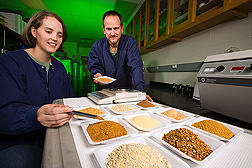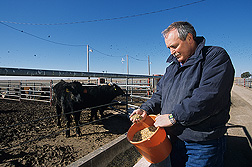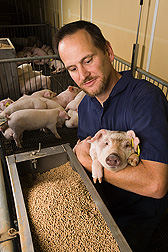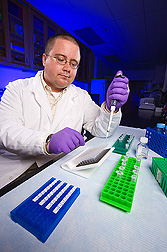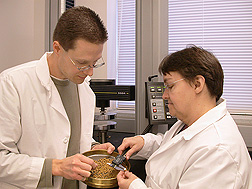Ethanol Byproducts Offer Savings for Farmers and Industry
|
|
Ethanol production has profoundly changed the scene in corn and livestock country. The high cost of field corn and its diversion from livestock feed to ethanol production have created the need to substitute ethanol production coproducts for some corn feed.
Distiller’s grains are the residual material from converting grain, such as corn or sorghum, into ethanol. Distiller’s grains are either wet (WDG) or dried (DDG). Adding back liquid solubles to distiller’s grains makes a coproduct known as “wet distillers grains with solubles” (WDGS). If dried, that mixture is known as “dried distiller’s grains with solubles” (DDGS). There are more than 20 forms of these coproducts, most of which are suitable as feed supplements for cattle, swine, and poultry.
ARS scientists across the country are testing the coproducts of ethanol and biodiesel production on hundreds of livestock, including beef cattle, dairy cows, pigs, poultry, and fish. They want to see whether and how distiller’s grains fit into feed rations. They’re testing the effects on every aspect of raising animals, from economics, animal growth and health, digestibility, meat and milk production, and carcass characteristics to environmental issues, such as the nitrogen and phosphorus content of manure.
|
|
Blending distiller’s grains into feed could lower costs for livestock producers and provide a market for recycling these ethanol coproducts, which are growing in supply as more and more ethanol is produced. In the Midwest alone, ethanol producers generate 10 million tons of DDG annually.
Recycling distiller’s grains is good for distillers, grain farmers, livestock producers, and the environment. It lowers the costs of ethanol production and helps offset some of the losses of field corn diverted to make ethanol.
The goal is to recycle distiller’s grains into as many products as possible, not only nutritious and low-cost livestock and aquaculture feed, but also human food supplements and nutraceuticals as well as nonfood products.
Andy Cole, an animal scientist at the ARS Renewable Energy and Manure Management Research Unit in Bushland, Texas, says as new ethanol plants of various sizes open and existing plants change their processing techniques, this affects the type of coproducts produced.
“We’ve found that coproducts change from plant to plant and within plants,” Cole says.
Other Great Grains
The researchers are also testing barley and sorghum, which could be used for biofuel production. Use of these and other alternative grain crops to produce ethanol is just one of many factors that make ethanol and byproducts research so dynamic.
Cole explains that distiller’s grains are likely to come from sorghum and corn in the Southern Plains. “This is one of the differences between Southern Plains and Northern Plains states,” Cole says. “There are more ethanol plants in the Northern Plains, and they have a head start on us. But we have larger feedlots, so management techniques are different here. Also, we feed our cattle steam-flaked corn rather than dry-rolled corn, which is common in the Northern Plains. Steam-flaked corn has more net energy than dry-rolled corn, so adding distiller’s grains tends to lower the feed-energy value of steam-flaked-corn-based diets. But with dry-rolled-corn-based diets, distiller’s grains probably add to the feed-energy value.”
With cooperators (see Collaborators in This Research below), Cole is testing WDGS from sorghum and corn and from blends of both. They’re combining sorghum-based distiller’s grains with steam-flaked corn in beef cattle finishing diets. They have also done some preliminary experiments at a large commercial dairy to study the feeding value of WDGS for lactating dairy cows.
Cole and his colleagues have tentatively found that WDGS are best used at 10 to 20 percent of the diet for beef cattle that are fed steam-flaked corn-based diets in the Southern Plains.
They are currently studying safety concerns, such as too much dietary sulfur, which can be fatal to cattle.
DDGS Fuel Pig Growth—and Health
Tom Weber, an ARS physiologist at the Swine Odor and Manure Management Research Unit in Ames, Iowa, says that rising feed costs and increasing use of corn for biofuel production have pushed swine producers to find new feed supplements for younger swine.
“Producers had already started using DDGS for older pigs, based on ARS studies of the benefits of supplementing swine feed with high-fiber byproducts such as DDGS. Now we’re looking at piglets.”
That is why Weber, research leader Brian J. Kerr, and ARS microbiologist Cherie Ziemer studied the effects of feeding fibrous coproducts to young pigs. The team divided weanling pigs into four groups and fed them either a standard control diet or a diet supplemented with DDGS, soybean hulls, or citrus pulp.
After 4 weeks, the researchers found that DDGS increased the immune response of piglets, possibly making them more resistant to illness. The response observed was an increase in cytokine expression in the pigs’ small intestines.
|
|
“This response could partially explain earlier findings that pigs with DDGS in their diets exhibited reduced levels of ileitis, a common inflammation of the small intestine,” Weber says.
“Our study shows that we can feed DDGS successfully to young pigs without altering their growth. And it’s clear that these DDGS may result in improved health.”
Over the past few years, Kerr, Weber, and Ziemer have conducted about a dozen studies with a swine herd at Iowa State University. Kerr is now studying energy and amino acid availability in 13 different coproducts of the corn-milling industry.
Weber agrees with Cole about the ever-changing nature of ethanol coproduct research: “It’s quite dynamic. As the processes change, you keep getting different forms of DDGS and other coproducts,” Weber says. “We have no lack of coproducts to study.”
Weber found that, for adult pigs, they can use up to 40 percent DDGS mixed with corn and soy-meal feed. For piglets, they use 7.5 percent, because the piglets tend to grow less with too much fiber.
Kurt Rosentrater, an agricultural and bioprocess engineer with the ARS North Central Agricultural Research Laboratory at Brookings, South Dakota, says the swine and poultry industries have been consuming more DDGS in recent years.
Rosentrater leads one of the largest DDGS utilization efforts in ARS, outside of the ARS regional research centers at Peoria, Illinois, and Wyndmoor, Pennsylvania. He works with faculty at South Dakota University, Northern Illinois University, and North Dakota State University, as well as several commercial entities. His research program is investigating methods of using DDGS as ingredients in cattle feed and human food and as fillers in biodegradable plastics. He is also examining the role of manufacturing conditions on the products’ chemical and physical properties and how these relate to storability and material-handling characteristics.
For example, Rosentrater sampled distiller’s grains coproducts at commercial ethanol plants in South Dakota. He found that they had nearly 30 percent protein and between 30 and 40 percent fiber, making them suitable as feed not only for livestock, but also for aquatic animals and pets.—By Don Comis and Ann Perry, Agricultural Research Service Information Staff.
This research is part of Manure and Byproduct Utilization (#206), Bioenergy and Energy Alternatives (#307), and Quality and Utilization of Agricultural Products (#306), three ARS national programs described on the World Wide Web at www.nps.ars.usda.gov.
To reach scientists mentioned in this article, contact Don Comis, USDA-ARS Information Staff, 5601 Sunnyside Ave., Beltsville, MD 20705-5129; phone (301) 504-1625, fax (301) 504-1486.
Other Uses for Distiller’s Grains
Here are some examples of other ARS research to recycle distiller’s grains into as many products as possible:
Human Food Supplements and Nutraceuticals
Phytosterols, lecithin, as well as carotenoid antioxidants, such as lycopene, are some of the ingredients that could be mass produced from distiller’s grains and sold as human food supplements. Some research along these lines is being done with Syngenta Corporation in Wilmington, Delaware.
ARS scientists are also searching many barley types for these kinds of healthy ingredients that can be gleaned from distiller’s grains, including from barley lines being developed at the ARS Small Grains and Potato Germplasm Research Unit in Aberdeen, Idaho. Research of the ARS National Center for Agricultural Utilization Research (NCAUR), Peoria, Illinois, and the ARS Eastern Regional Research Center, Wyndmoor, Pennsylvania.
Better Fish Feed
Barley DDGS with improved nutritional value can be used as a new feed for rainbow trout. Research of the ARS Small Grains and Potato Germplasm Research Unit, Hagerman Fish Culture Experiment Station, Hagerman, Idaho.
Adding lysine allowed tilapia to thrive on feed with 40 percent DDGS or more. Catfish fed DDGS-containing diets showed more resistance to enteric septicemia, a major fish disease. Research of the ARS Aquatic Animal Health Research Unit, Auburn, Alabama.
Mulch
Distiller’s grains can make a mulch that is both an organic fertilizer and a weed-inhibitor. ARS has a cooperative research and development agreement with Summit Seed Incorporated of Manteno, Illinois, on this research. Research of NCAUR, Peoria, Illinois.
Collaborators in This Research
• The Consortium for Cattle Feeding and Environmental Science, which includes West Texas A&M University, Texas Tech University, New Mexico State University/Clayton Livestock Research Center, Texas AgriLife Research, Texas AgriLife Extension Service, Texas Veterinary Medical Diagnostic Laboratory, the Texas Cattle Feeders Association, and the USDA Agricultural Research Service.
• The National Sorghum Producers and the Texas Corn Producers Board.
• Kansas State University, Oklahoma State University, and the University of Minnesota at St. Paul.
"Ethanol Byproducts Offer Savings for Farmers and Industry" was published in the February 2009 issue of Agricultural Research magazine.







